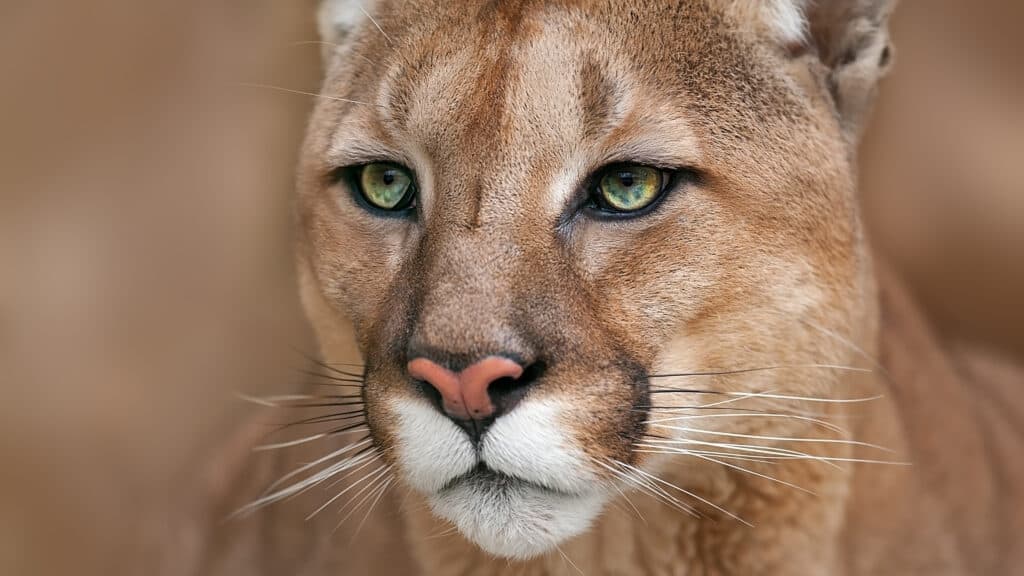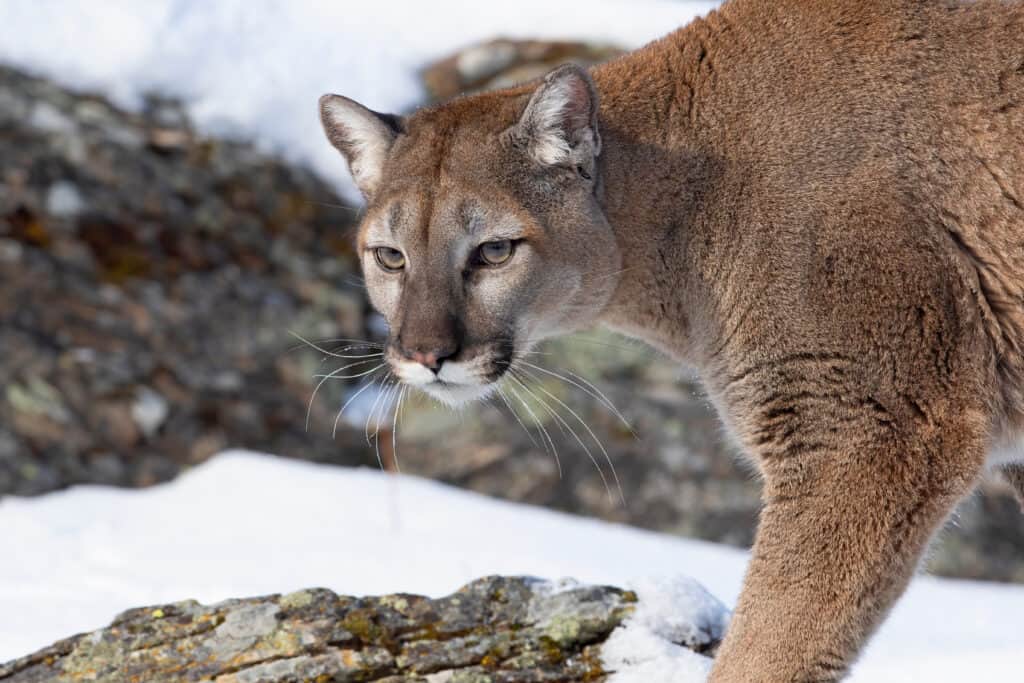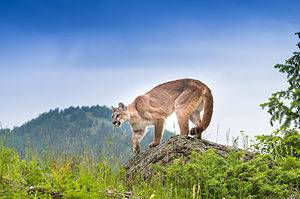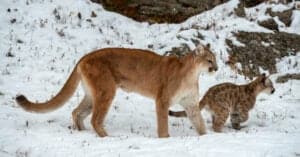Residents of Kansas are no strangers to abundant wildlife. The state is home to many wonderful species. However, there is one particular species of animal that captures nearly everyone’s imagination. And that is the elusive mountain lion. News reports and trail camera footage clearly show the presence of the large cat throughout the state. But do mountain lions live in Kansas? Or are they merely passing through?
Below we explore these questions, and a few basic facts about the impressive animal. Keep reading to discover whether or not there are mountain lions in Kansas.
What Are Mountain Lions?
There are a lot of misconceptions floating around about mountain lions. So before we take a detailed look at mountain lions in Kansas, it will help to look at some basic details.
Mountain lions (Puma concolor) belong to the Felidae (cat) family. There were multiple subspecies historically, though some of those are now extinct. Some names commonly used to refer to mountain lions include puma, panther, catamount, and cougar.
Mountain lions’ distinctive coloring provides natural camouflage in nearly every environment. Their fur is primarily tan, brown, or reddish-orange, and they have white underbellies and chests. Additionally, the large cats have black accents on their snout, eyes, ears, and tips of their tails.
They are the largest cat in North America, growing up to 225 pounds and 9 feet long (including the tail). Adult males are the largest, averaging 140 pounds and 7 feet long. The smaller adult females typically weigh around 80-90 pounds.

Mountain lions are also known as pumas, panthers, catamounts, and cougars.
©iStock.com/Nemyrivskyi Viacheslav
Mountain Lion Habitat
The large cat lives in incredibly diverse environments. It has the widest habitat range of any mammal in the Americas, extending from the Yukon down to Chile. Additionally, numerous subspecies of mountain lions live in deserts, wetlands, forests, and mountains. They are more concerned with the availability of food than their surroundings.
Mountain lions roamed through every state in the United States. However, habitat destruction and hunting practices decimated most of the populations in the late 1800s and early 1900s. Now, only 15 states have established mountain lion populations. And Florida has a small population of one particular subspecies, the Florida panther.
The impressive animal is solitary, and each has a large home territory. Adult males cover approximately 100 square miles, while adult females only roam roughly 60 square miles. After juvenile mountain lions get old enough to strike out on their own, they must find a new home territory.

Mountain lions are happy in nearly any habitat, including forests, mountains, wetlands, and deserts.
©eumates/Shutterstock.com
Where Do Mountain Lions Live in Kansas?
Historically, mountain lions were common in Kansas. They freely roamed throughout the state. However, as settlements grew and expanded, pressure got put on the mountain lion’s habitat. Additionally, many settlers feared the ferocious animal would decimate livestock populations. The habitat loss and hunting practices of local residents rapidly reduced the mountain lion population in Kansas in the late 1800s.
There was one remaining documented mountain lion after the turn of the century. But it was shot and killed in Ellis County in 1904. After that, the state went roughly 100 years without any documented sightings. And while there are an increasing number of reported sightings, there is no physical evidence of a breeding population in Kansas.
Kansas does not have a hunting season for mountain lions as they are protected animals. But, if you encounter a mountain lion that is damaging your property, harming your animals, or you feel like your life is in danger, it is legal to kill the cat. However, state officials encourage using other efforts to solve the problem before resorting to killing it.

There is no longer a breeding population of mountain lions in Kansas.
©Jim Cumming/Shutterstock.com
Mountain Lion Sightings in Kansas
While there has not been a breeding population of mountain lions in Kansas since 1904, the state is close to many established mountain lion populations in other states. Mountain lions from Colorado and South Dakota have started wandering into nearby states, including Kansas, as they look for new territory.
Most of those found wandering are likely juvenile males searching for new home territory. Kansas wildlife officials have seen little evidence that the large cats remain in the state. Instead, they believe all confirmed mountain lion sightings are of cats simply passing through.
The first confirmed mountain lion sighting since 1904 occurred in 2007. A mountain lion was shot and killed in Barber County. Since then, reports of sightings have steadily increased. There have been 40 confirmed and documented sightings since 2007. Two of those sightings made news headlines in the state.
At the end of 2020, three separate mountain lions traveled through the state. And then, in 2021, a mountain lion made its way through Wichita. Two ring doorbells captured the elusive cat eight days apart as it traveled through the city.
Officials with the Department of Wildlife & Parks take reported mountain lion sightings seriously and investigate each one. Most reports they receive come from footage captured by trail cameras placed by hunters throughout the state.
However, many reported sightings turn out to be other animals. Some animals commonly mistaken for mountain lions include coyotes, bobcats, domesticated cats, and dogs. Sometimes the light or angle of a trail camera can play tricks on the eyes, making a smaller animal appear much larger.

Mountain lion sightings in Kansas have increased over the last few decades, with roughly 40 confirmed sightings since 2007.
©Chris Alcock/Shutterstock.com
How to Avoid Getting Attacked by a Mountain Lion in Kansas
Due to the proximity of breeding populations in nearby states, mountain lions are becoming increasingly common in Kansas. And although wildlife officials believe the large cats are only passing through the state, in reality, there is a presence (even if minimal). Therefore, it is vital to understand some basic safety guidelines and how to avoid getting attacked by a mountain lion.
The large felines prefer to hunt during lower light times of the day. So avoid hitting the trail early in the morning or during the twilight hours, if at all possible.
If you are out on outdoor adventures with kids or pets, keep them close by rather than letting them wander. In the rare event you encounter a mountain lion, make yourself appear larger and yell at it. You will also want to help your smaller companions appear bigger by picking them up so they are less tempting.
Slowly back away from the mountain lion without turning your back or running. Either of these actions is likely to trigger the predator’s hunting instincts. And if the mountain lion does attack, fight back instead of playing dead.
However, it is important to note that mountain lion attacks are extremely rare. So the chances of you encountering a mountain lion, much less getting attacked by one, are slim.

Mountain lion attacks on humans are very rare.
©iStock.com/SandmanXX
The photo featured at the top of this post is © Warren Metcalf/Shutterstock.com
Sources
- Kansas Department of Wildlife and Parks, Available here: https://ksoutdoors.com/Wildlife-Habitats/Wildlife-Sightings#:~:text=The%20first%20confirmed%20mountain%20lion,in%201904%20in%20Ellis%20County.
FAQs (Frequently Asked Questions)
What big cats are in Kansas?
The last remaining big cat native to Kansas is the bobcat.
Are cougars found in Kansas?
Cougar is another name for mountain lion. And there is not a breeding population of mountain lions in the state.
How rare is it to see a mountain lion?
The large cats are extremely elusive and secretive animals. They are also silent stalkers. So the chances of ever seeing or encountering a mountain lion are quite slim.
Thank you for reading! Have some feedback for us? Contact the AZ Animals editorial team.






